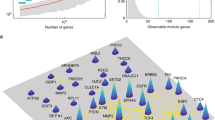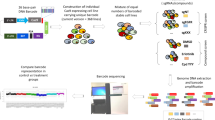ABSTRACT
Pharmacogenomics requires massive computer exploration on heterogeneous databases. COMPARE, the gateway to the NCI's anticancer drug screen database, allows users to correlate drug-sensitivity profiles with a functional genomic database. However, most drugs of known molecular mechanism turn out to be uncorrelated with their molecular–target gene expression. Based on a novel statistical concept, liquid association, we develop an on-line system to identify candidate genes that intervene, confound and weaken the drug–gene correlation. The system takes queries and returns button-clickable tables of functionally associated genes for rerouting to knowledgebases such as Locus Link, OMIM and PubMed. We report results that link methotrexate resistance to DNA component biosynthesis, and taxol sensitivity to genes associated with human immunodeficiency virus infection. The drug-sensitivity database can be synergistically coanalyzed with gene expression data to study proteins of poorly understood physiological roles. When applied to the human prion, a cellular context embroidered with the gene expression network of Alzheimer disease is revealed.
This is a preview of subscription content, access via your institution
Access options
Subscribe to this journal
Receive 6 print issues and online access
$259.00 per year
only $43.17 per issue
Buy this article
- Purchase on Springer Link
- Instant access to full article PDF
Prices may be subject to local taxes which are calculated during checkout




Similar content being viewed by others
References
Boyd MR, Paull KD, Rubinstein LR In: Vleriote FA, Corbett TH, Baker LH (eds). Cytotoxic Anticancer Drugs: Models and Concepts for Drug Discovery and Development. Kluwer Academic Publishers: Hingham, MA 1992; pp 11–34.
DeVita VT, Hellman S, Rosenberg SA Cancer: Principles and Practice of Oncology, 6th edn Lippincott Williams and Wilkins: Philadelphia 2001; pp 349, 439, 2579–2580.
Ross DT, Scherf U, Eisen MB, Perou CM, Rees C, Spellman P et al. Systematic variation in gene expression patterns in human cancer cell lines. Nat Genet 2001; 24: 227–235.
Scherf U, Ross DT, Waltham M, Smith LH, Lee JK, Tanabe L et al. A gene expression database for the molecular pharmacology of cancer. Nat Genet 2000; 24: 236–244.
Staunton JE, Slonim DK, Coller HA, Tamayo P, Angelo MJ, Park J et al. Chemosensitivity prediction by transcriptional profiling. Proc Natl Acad Sci USA 2001; 98: 10787–10792.
Li KC . Genome-wide co-expression dynamics: theory and application. Proc Natl Acad Sci USA 2002; 99: 16875–16880.
Banerjee D, Mayer-Kuckuk P, Capiaux G, Budak-Alpdogan T, Gorlick R, Bertino JR . Novel aspects of resistance to drugs targeted to dihydrofolate reductase and thymidylate synthase. Biochim Biophys Acta 2002; 1587: 164–173.
Voet D, Voet JG Biochemistry second edition 810–811 and 815; Figures 26-16, 26-20. John Wiley & Sons, Inc.: New York 1995.
Becker K, Gromer S, Schirmer RH, Muller S . Thioredoxin reductase as a pathophysiological factor and drug target. Eur J Biochem 2000; 267: 6118–6125.
Ohki R, Nemoto J, Murasawa H, Oda E, Inazawa J, Tanaka N et al. Reprimo, a new candidate mediator of the p53-mediated cell cycle arrest at the G2 phase. J Biol Chem 2000; 275: 22627–22630.
Marks B, Stowell MH, Vallis Y, Mills IG, Gibson A, Hopkins CR et al. GTPase activity of dynamin and resulting conformation change are essential for endocytosis. Nature 2001; 410: 231–235.
Lee E, De Camilli P . Dynamin at actin tails. Proc Natl Acad Sci USA 2002; 99: 161–166.
Ramos-Morales F, Vime C, Bornens M, Fedriani C, Rios RM . Two splice variants of Golgi–microtubule-associated protein of 210 kDa (GMAP-210) differ in their binding to the cis-Golgi network. Biochem J 2001; 357(Part 3): 699–708.
Rincon-Arano H, Rosales R, Mora N, Rodriguez-Castaneda A, Rosales C . R-Ras promotes tumor growth of cervical epithelial cells. Cancer 2003; 97: 575–585.
Blagoveshchenskaya AD, Thomas L, Feliciangeli SF, Hung CH, Thomas G . HIV-1 Nef downregulates MHC-I by a PACS-1- and PI3K-regulated ARF6 endocytic pathway. Cell 2002; 111: 853–866.
Linnemann T, Zheng YH, Mandic R, Peterlin BM . Interaction between Nef and phosphatidylinositol-3-kinase leads to activation of p21-activated kinase and increased production of HIV. Virology 2002; 294: 246–255.
Cook JA, August A, Henderson AJ . Recruitment of phosphatidylinositol 3-kinase to CD28 inhibits HIV transcription by a Tat-dependent mechanism. J Immunol 2002; 169: 254–260.
Bobardt MD, Saphire AC, Hung HC, Yu X, Van der Schueren B, Zhang Z et al. Syndecan captures, protects, and transmits HIV to T lymphocytes. Immunity 2003; 18: 27–39.
Saphire AC, Bobardt MD, Zhang Z, David G, Gallay PA . Syndecans serve as attachment receptors for human immunodeficiency virus type 1 on macrophages. J Virol 2001; 75: 9187–9200.
Richardson RM, Tokunaga K, Marjoram R, Sata T, Snyderman R . Interleukin-8-mediated heterologous receptor internalization provides resistance to HIV-1 infectivity. Role of signal strength and receptor desensitization. J Biol Chem 2003; 278: 15867–15873.
Farzan M, Babcock GJ, Vasilieva N, Wright PL, Kiprilov E, Mirzabekov T et al. The role of post-translational modifications of the CXCR4 amino terminus in stromal-derived factor 1 alpha association and HIV-1 entry. J Biol Chem 2002; 277: 29484–29489.
Alfano M, Sidenius N, Panzeri B, Blasi F, Poli G . Urokinase–urokinase receptor interaction mediates an inhibitory signal for HIV-1 replication. Proc Natl Acad Sci USA 2002; 99: 8862–8867.
Cavallaro U, Wu Z, Di Palo A, Montesano R, Pepper MS, Maier JA et al. FGF-2 stimulates migration of Kaposi's sarcoma-like vascular cells by HGF-dependent relocalization of the urokinase receptor. FASEB J 1998; 12: 1027–1034.
Branch DR, Valenta LJ, Yousefi S, Sakac D, Singla R, Bali M et al. VPAC1 is a cellular neuroendocrine receptor expressed on T cells that actively facilitates productive HIV-1 infection. AIDS 2002; 16: 309–319.
Ray RB, Srinivas RV . Inhibition of human immunodeficiency virus type 1 replication by a cellular transcriptional factor MBP-1. J Cell Biochem 1997; 64: 565–572.
Carter RE, Cerosaletti KM, Burkin DJ, Fournier RE, Jones C, Greenberg BD et al. The gene for the serpin thrombin inhibitor (PI7), protease nexin I, is located on human chromosome 2q33-q35 and on syntenic regions in the mouse and sheep genomes. Genomics 1995; 27: 196–199.
Fischer MB, Roeckl C, Parizek P, Schwarz HP, Aguzzi A . Binding of disease-associated prion protein to plasminogen. Nature 2000; 408: 479–483.
Ellis V, Daniels M, Misra R, Brown DR . Plasminogen activation is stimulated by prion protein and regulated in a copper-dependent manner. Biochemistry 2002; 41: 6891–6896.
Kornblatt JA, Marchal S, Rezaei H, Kornblatt MJ, Balny C, Lange R et al. The fate of the prion protein in the prion/plasminogen complex. Biochem Biophys Res Commun 2003; 305: 518–522.
Lomas DA, Carrell RW . Serpinopathies and the conformational dementias. Nat Rev Genet 2002; 3: 759–768.
Chen S, Mange A, Dong L, Lehmann S, Schachner M . Prion protein as trans-interacting partner for neurons is involved in neurite outgrowth and neuronal survival. Mol Cell Neurosci 2003; 22: 227–233.
Li G, Faibushevich A, Turunen BJ, Yoon SO, Georg G, Michaelis et al. Stabilization of the cyclin-dependent kinase 5 activator, p35, by paclitaxel decreases beta-amyloid toxicity in cortical neurons. J Neurochem 2003; 84: 347–362.
Rehman HU . Role of CRH in the pathogenesis of dementia of Alzheimer's type and other dementias. Curr Opin Invest Drugs 2002; 2002: 1637–1642.
Gayrard V, Picard-Hagen N, Grino M, Sauze N, Grandjean C, Galea J et al. Major hypercorticism is an endocrine feature of ewes with naturally occurring scrapie. Endocrinology 2000; 141: 988–994.
Brown DR, Schmidt B, Kretzschmar HA . Prion protein fragment interacts with PrP-deficient cells. J Neurosci Res 1998; 52: 260–267.
Efferth T, Verdorfer I, Miyachi H, Sauerbrey A, Drexler HG, Chitambar CR et al. Genomic imbalances in drug-resistant T-cell acute lymphoblastic CEM leukemia cell lines. Blood Cells Mol Dis 2002; 29: 1–13.
Shingu T, Yamada K, Hara N, Moritake K, Osago H, Terashima M et al. Synergistic augmentation of antimicrotubule agent-induced cytotoxicity by a phosphoinositide 3-kinase inhibitor in human malignant glioma cells. Cancer Res 2002; 63: 4044–4047.
Axmark D, Widenius M, MySQL AB. MySQL Reference Manual, 1st edition O'Reilly & Associates: Sebastopol, CA 2002.
Trachtenberg A and Sklar D . PHP Cookbook. O'Reilly & Associates: Sebastopol, CA 2002.
Koh CG, Tan EJ, Manser E, Lim L . The p21-activated kinase PAK is negatively regulated by POPX1 and POPX2, a pair of serine/threonine phosphatases of the PP2C family. Curr Biol 2002; 12: 317–321.
Colombo E, Marine JC, Danovi D, Falini B, Pelicci PG . Nucleophosmin regulates the stability and transcriptional activity of p53. Nat Cell Biol 2002; 4: 529–533.
Adamec E, Mohan P, Vonsattel JP, Nixon RA . Calpain activation in neurodegenerative diseases: confocal immunofluorescence study with antibodies specifically recognizing the active form of calpain 2. Acta Neuropathol (Berl) 2002; 104: 92–104.
Wiltshire C, Matsushita M, Tsukada S, Gillespie DA, May GH . A new c-Jun N-terminal kinase (JNK)-interacting protein, Sab (SH3BP5), associates with mitochondria. Biochem J 2002; 367: 577–585.
McClintock KA, Shaw GS . A novel S100 target conformation is revealed by the solution structure of the Ca2+–S100B–TRTK-12 complex. J Biol Chem 2003; 278: 6251–6257.
Stortelers C, van De Poll ML, Lenferink AE, Gadellaa MM, van Zoelen C, van Zoelen EJ . Epidermal growth factor contains both positive and negative determinants for interaction with ErbB-2/ErbB-3 heterodimers. Biochemistry 2002; 41: 4292–4301.
Bhatt RS, Tomoda T, Fang Y, Hatten ME . Discoidin domain receptor 1 functions in axon extension of cerebellar granule neurons. Genes Dev 2000; 14: 2216–2228.
Gormley K, Dong Y, Sagnella GA . Regulation of the epithelial sodium channel by accessory proteins. Biochem J 2003; 371(Part 1): 1–14.
Acknowledgements
This work was funded in part by NSF Grants 0104038 and 0201005. We appreciate comments from anonymous referees that led to improved presentation.
Author information
Authors and Affiliations
Corresponding author
Additional information
DUALITY OF INTEREST
UCLA has filed a patent application protecting the methodology of liquid association. Commercialization of the patent may result in benefits to the authors affiliated with UCLA.
Supplementary information
Rights and permissions
About this article
Cite this article
Li, KC., Yuan, S. A functional genomic study on NCI's anticancer drug screen. Pharmacogenomics J 4, 127–135 (2004). https://doi.org/10.1038/sj.tpj.6500235
Received:
Revised:
Accepted:
Published:
Issue Date:
DOI: https://doi.org/10.1038/sj.tpj.6500235
Keywords
This article is cited by
-
Genome-wide trait-trait dynamics correlation study dissects the gene regulation pattern in maize kernels
BMC Plant Biology (2017)
-
Genome-wide expression links the electron transfer pathway of Shewanella oneidensis to chemotaxis
BMC Genomics (2010)
-
Prédiction de la réponse aux anticancéreux par analyse du transcriptome
Bio Tribune Magazine (2007)
-
Linking pathway gene expressions to the growth inhibition response from the National Cancer Institute's anticancer screen and drug mechanism of action
The Pharmacogenomics Journal (2005)



